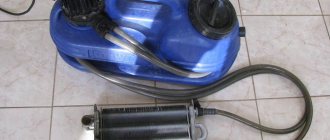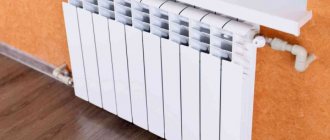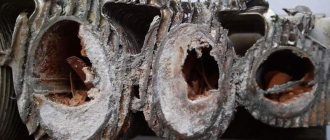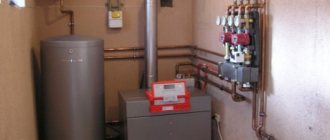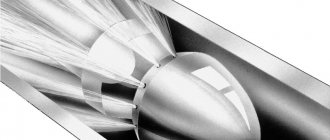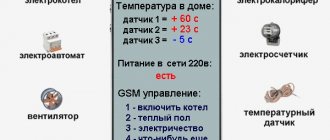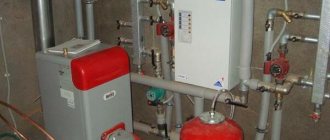Cleaning chemicals
Among them are the most common types of funds:
- adipic acid;
- hydrochloric acid;
- sulfamic acid.
You should never forget that these are aggressive substances, so you should always be careful when working with chemical solutions. (Read about the features of chemical boiler flushing in this article)
Expert advice: the concentration of acidic solutions for washing should be 1% per 1 mm of scale layer!
Watch the video in which an experienced user explains how to descale a gas boiler yourself:
Types of maintenance
When servicing hot water boilers, one of the priority stages is considered to be cleaning the entire system from the resulting scale. Descaling is carried out in several stages.
First, the scale is successively loosened, after which it is washed out with water. This is followed by mechanical cleaning.
Chemical cleaning
To perform chemical cleaning of boiler equipment, a solution of inhibited hydrochloric acid is supplied to it. The acid is adjusted to the required concentration, not exceeding 10%.
Next, after a certain time, they take a sample of the solution, and then check for scale solubility.
If scale does not dissolve even when the solution is heated to the maximum permissible concentration, ammonium fluoride or sodium fluoride is added to it at the rate of 20-30 grams per liter.
Pellet boilers are a type of solid fuel heating boilers that are quickly gaining popularity due to their low cost and efficiency.
How to correctly calculate the power of a gas boiler, read here.
Acid wash
Acid washing of hot water boilers is carried out through forced circulation using special pumps.
The work of purging equipment begins with the lower drum.
It is worth paying attention to the fact that if the density of the solution does not change critically, then the process ends there. After completing the acid wash, the system is washed with water, and the remaining acid is neutralized with an alkaline solution (caustic soda).
Alkaline washing
In addition to performing an acid wash, an alkaline wash can be used. This method involves loosening scale using caustic or soda ash, which is added to a cooled boiler unit. The amount of soda should be 1-2% by weight of water.
Next, the boiler is heated until a pressure of 1.5-2 kilograms per square centimeter is obtained. In this state, boiling is maintained for 15 hours, while the equipment is regularly purged.
The installation is cooled and then the sludge is washed with a stream of cold water. After this, it is necessary to perform mechanical cleaning (if scale remains).
Main features of gas boiler servicing.
Wood-burning boilers, read here.
To dissolve carbonate scale, trisodium phosphate is added to the alkali solution at the rate of 2 kilograms per cubic meter of water, after which the standard alkalization procedure is carried out.
Boiling is carried out throughout the day, then most of the water is removed (more than 50%) and the initial solution is added.
If necessary, the procedure is repeated. After the end of alkalization, sludge with water is released. Finally, mechanical cleaning is performed.
SP-OM
The complex product of the SP-OM brand is used for flushing heating systems, heat exchangers, boilers and any other heat exchange equipment. Can be used in open and closed heat exchange circuits. "SP-OM" does not destroy aluminum and polymer elements of the system, as well as rubber gaskets. It has proven itself well on an industrial scale. There are various brands of SP-OM designed for specific operating conditions. Manufacturer's website - https://spomcom.ru/
SP-OM Pros
- effective removal of scale, rust and other deposits;
- wash-in-place;
- does not corrode rubber gaskets and seals;
- prevents corrosion of ferrous metals;
- may further include a corrosion inhibitor;
- Can be used with aluminum parts.
Minuses
Consultation and services of a flushing specialist may be required.
SP-OM
Metalin T is a product made on the basis of hydrochloric acid. Removes heavy lime deposits, rust products and organic matter in heating systems made of steel or non-ferrous metals. It is a non-flammable substance. After adding an alkaline neutralizer, the waste is allowed to be drained into the sewer. Packaged in concentrated form in containers from 1 to 30 liters.
Metalin T Pros
- non-flammable;
- quick cleansing.
Minuses
- after neutralization with alkali, discharge into the sewer system is allowed;
- not used for treating surfaces made of aluminum and its alloys.
Used in the treatment of pressure boilers, tubular heat exchange devices, boilers, condensers, pipelines in industry and domestic conditions. Removes various types of contaminants, in particular limestone and corrosive deposits. Ideal for washing plastic, metal and rubber pipes. Cleans carefully and does not have a negative effect on the structure of the seals. Not recommended for cleaning systems with surfaces made of aluminum and derivative alloys. Preliminary testing on treated stainless steel surfaces is also recommended.
SYNTILOR Watesup Pros
- does not affect the structure of metals;
- concentrated product;
- high efficiency even at low operating temperatures (20–35°C);
- does not damage seals and rubber gaskets;
- contains an inhibitor.
Minuses
Heating system cleaner SYNTILOR Watesup
Deoxyl-3
Deoxyl-3 is an acid-type product for chemical cleaning of pipelines in heating and water supply systems. It is packaged as a concentrate in 20 liter containers. The liquid is not flammable and belongs to toxicity class 3. For a greater cleaning effect, it is advisable to use the Deoxyl NO additive together with the drug. Foaming is neutralized by the Foral PG additive. The liquid is quite aggressive, so when working with it it is recommended to protect the skin and respiratory organs with protective equipment. Use strictly according to label instructions.
Deoxyl-3 Pros
- completely removes scale-corrosion deposits regardless of the design features of the equipment;
- biodegradable;
- after washing, the spent working solution can be drained into the sewer;
- The composition includes various inhibitors that prevent metal etching and the appearance of corrosion. Inhibitors not only remove deposits, but also protect the metal.
Minuses
The liquid is aggressive (work with it only with protective equipment).
Which system flushing products would you choose or would you recommend purchasing?
Deoxyl-3
44.44% ( 4 )
Save your voting results so you don't forget!
To see the results you need to vote
Instructions for flushing the heating system
Pneumatic pulse cleaning scheme
There are 2 main methods for flushing the heating system, namely:
- using special hydropneumatic equipment;
- using chemical reagents.
Flushing using the hydropneumatic method
Hydropneumatic flushing of heating systems - instructionsHydropneumatic flushing of heating systems - instructions
This method is actively used by domestic housing offices and is quite effective. You just need to do everything in accordance with technology.
The principle is extremely simple: first, water is discharged from the system, then it is supplied back. A special pneumatic pump is used to “adjust” the water flow. As a result, under the influence of a fairly powerful pressure, scale and other deposits peel off, and when the water is drained, they are removed from the system.
To carry out this procedure yourself, you will need a pneumatic pump capable of pumping a pressure of more than 6 kg/cm2.
The sequence of actions is as follows.
Before starting work, you need to turn off all the taps. The end fittings are unscrewed using a wrench.
First step. We close the return valve.
Heating system line diagram
Second step. We connect the pneumatic pump to the valve installed after the valve.
Third step. We reset the return line.
Fourth step. Let the pneumatic pump build up pressure above 6 kg/cm2, and then open the valve to which it is connected.
Fifth step. We close off all the risers one by one. We do this so that no more than 10 risers are blocked at one time. Compliance with this rule will make the washing procedure as effective as possible.
Sixth step. We switch the system to reset in the opposite direction. To do this we do the following:
- close the discharge and close the valve connected to the pump, and turn off the device;
- close the open valve, and then open a similar one on the “return”;
- we reset the heating system. To do this, connect the pneumatic pump to the valve in the opposite direction, then open the valve and turn on the pump. The liquid will move in a different direction.
You can determine the required duration of rinsing by eye. Has clear clear liquid started coming out of the system? We can finish! Return the gates and valves to their original positions and turn off the pump.
Prepare a suitable container to collect dirty water. If you wish, you can connect a hose to the battery and ensure that the dirty coolant is discharged into the sewer.
Chemical wash
Chemical pipe flushing diagram
This method can be used only in two cases, namely:
- if it is necessary to clean a heating system with natural circulation, built using steel pipes. It is advisable to use chemical reagents in situations where, for any reason, there is no desire to flush the entire system. Most often, blockages are deposited in heat exchangers. The system can silt around the entire perimeter. In the second case, chemical washing will not be of much use;
- if it is necessary to restore the old heating system. Over decades of operation, pipes can become clogged and overgrown so much that the power of the pneumatic pump will not be enough for effective cleaning. It would, of course, be possible to use a more powerful pump, but no one can guarantee that the pipes will not burst under such pressure.
Wash reagent
The principle of flushing is simple: instead of coolant, a special solution containing acid and alkali is poured into the system. Then the mixture is circulated for 2-3 hours (if it is not the natural circulation line that is being cleaned, you will need to connect a pneumatic pump for this), after which it is drained and the pipes are filled with standard coolant.
Reagents for flushing and protecting heating systems
Never use such chemical mixtures to clean aluminum pipes. If the products remain intact after such washing, they will serve significantly less.
It is recommended to carry out mandatory flushing of the system of a private home at least once every 7 to 10 years.
Chemical washing, as well as passivation of boilers and other thermal power equipment
LLC "Teploservice - Ekaterinburg" carries out in-place chemical cleaning of various heat and power equipment, such as:
- plate heat exchangers, - shell-and-tube heat exchangers, - boilers, - air heaters, - pipeline sections, etc.
Specially selected certified chemical reagents are used for washing. The work is carried out using acid-resistant pumping units by circulating chemicals in the equipment being washed with constant pH control of the washing solution.
Our company has been servicing various thermal power equipment for a long time, incl. chemical (acid) washing of boilers (both domestic and industrial with a volume of up to 75 m3!) and maintenance of heating systems.
Operating a boiler inevitably involves the problem of flushing it. Boiler flushing is a set of measures aimed at removing from its internal surface deposits, contaminants and scale that form on the walls of the boiler during operation.
During the operation of fire tube, hot water and other boilers, impressive layers of chemical deposits gradually accumulate on their internal walls, mainly consisting of:
- trivalent iron oxides (about 90%), - calcium and magnesium salts, usually carbonates, in the amount of up to 10%
Our company’s employees use reagents based on various acids to wash boilers, which loosen and dissolve scale and deposits when cleaning boilers, thereby allowing partial or complete restoration of the functionality of the boiler quite simply, cheaply and quickly.
In general terms, the process of chemical boiler flushing is as follows. First of all, the water is drained from the boiler circuit, then a chemical washing unit is connected to the boiler, which includes a tank with a reagent and a reverse pump. Using a chemical washing installation, a reagent for washing it, consisting of an acid solution, is pumped into the boiler. After this, the solution begins to circulate through the boiler pipes. The circulation time of the acid solution depends on the size of the boiler, the degree of contamination, the nature of deposits and on average ranges from 4 to 24 hours.
After the reagent completely dissolves scale and deposits during the circulation process when flushing the boiler, the water with dissolved deposits is neutralized, drained from the boiler and disposed of.
The cleaning process is completed by flushing the boiler with water until all deposits dissolved during cleaning are removed from the boiler with running water.
Advantages of acid washing of boilers compared to other types of cleaning:
- flushing the boiler reduces fuel and electricity consumption by 10% or more
- flushing the boiler increases the time between repairs of its operation
- flushing the boiler improves the environmental conditions of the air basin
- Chemical boiler flushing is a practical and inexpensive way to clean it in accordance with the manufacturer's recommendations, and at the same time, at minimal cost and with maximum efficiency.
We recommend chemical flushing of thermal power equipment on a regular basis. This will allow you to achieve the removal of up to 100% of deposits, prevent such undesirable consequences as a decrease in productivity, an increase in hydraulic resistance, and also minimize the risk of corrosion on the internal surfaces of the boiler, which can occur as a result of exposure to deposits (formed during operation), which allows for maximum extend its service life.
The final stage of chemical cleaning is passivation of the cleaned boiler surfaces.
The purpose of passivation is to protect the internal heating surfaces of the boiler from scale, rust and other inorganic deposits. The use of chemical reagents based on orthophosphoric acid makes it possible to effectively cope with this task in the most gentle way, without damaging the integrity of the metal. As a result of the conversion of metallic rust into iron phosphates, a film remains on the treated surfaces, providing reliable protection against further corrosion damage, and also reduces the rate of formation of new deposits.
Such a film must be created to prevent metal corrosion after chemical cleaning. The main reasons causing corrosion of boiler surfaces after chemical cleaning are:
1) water washings, carried out after chemical cleaning with industrial water saturated with a large amount of oxygen, chlorides and sulfates, which contribute to intense corrosion (rusting) of the metal;
2) a long break between the chemical cleaning process and putting the boiler into normal operation, during which work is carried out to dismantle the flushing and install the operating circuit. During the same period, pressure testing of the installed equipment is carried out by repeated filling it and subsequent emptying it to identify and eliminate defects. This creates favorable conditions for the development of atmospheric metal corrosion, which occurs in a thin film of electrolyte with an intensive supply of oxygen to the metal surface.
It is necessary to understand that chemical flushing of boilers, despite its apparent simplicity, is quite complex technical operations associated with working with caustic materials and specialized technical equipment.
To carry out chemical cleaning of boilers, we strongly recommend that you use the services of only specialized organizations that have the appropriate qualifications and experience in performing such work.
Appendix 2
Consumption of reagents for boiler alkalization
| Boiler type | Water volume, m3 | Reagent consumption, kg, at dosage, kg/m3 | ||||||
| 1 | 2 | 3 | 4 | 5 | 6 | 7 | ||
| TP-80 | 115 | 115 | 230 | 345 | 460 | 575 | 690 | 805 |
| TP-82 | 115 | 115 | 230 | 345 | 460 | 575 | 690 | 805 |
| TP-10 | 88,2 | 88 | 176 | 265 | 358 | 441 | 529 | 617 |
| TP-12 | 85 | 85 | 170 | 255 | 340 | 425 | 510 | 595 |
| TP-15 | 87,4 | 87 | 175 | 262 | 350 | 437 | 524 | 612 |
| TP-230-2 | 71,6 | 72 | 143 | 215 | 286 | 385 | 430 | 501 |
| TP-170-1 | 56,7 | 57 | 113 | 170 | 227 | 284 | 340 | 397 |
| TP-200-2 | 67 | 67 | 134 | 201 | 268 | 335 | 402 | 469 |
| TP-150-1 | 52 | 52 | 104 | 156 | 208 | 260 | 312 | 364 |
| PK-10, PK-10-2 | 61 | 61 | 122 | 183 | 244 | 305 | 366 | 427 |
| PK-14, PK-14-2 | 63 | 63 | 126 | 189 | 252 | 315 | 378 | 441 |
| PK-19, PK-19-2 | 57 | 57 | 114 | 171 | 228 | 235 | 342 | 399 |
| PK-20, PK-20-2 | 58 | 58 | 116 | 174 | 232 | 290 | 348 | 406 |
| BKZ-220-100F | 66 | 66 | 132 | 198 | 264 | 330 | 396 | 462 |
| BKZ-210-100F | 64 | 64 | 128 | 192 | 256 | 320 | 384 | 448 |
| BKZ-160-100F | 48 | 48 | 96 | 144 | 192 | 240 | 288 | 336 |
| BKZ-75-89-FB | 30 | 30 | 60 | 90 | 120 | 150 | 180 | 210 |
| TsKTI-75-39F | 30,4 | 30 | 61 | 91 | 122 | 152 | 182 | 213 |
| BKZ-75-39SL | 32,6 | 33 | 65 | 98 | 130 | 163 | 196 | 228 |
| BKZ-50-39F | 21,2 | 21 | 42 | 64 | 85 | 106 | 127 | 143 |
| TP-35U | 13,3 | 13 | 27 | 40 | 53 | 67 | 80 | 93 |
| TS-35U | 13,07 | 13 | 27 | 39 | 52 | 65 | 78 | 92 |
| TP-20-U | 9,33 | 9 | 19 | 28 | 87 | 47 | 56 | 65 |
| TS-20-U | 10,73 | 11 | 21 | 32 | 43 | 54 | 64 | 75 |
| DKVR-10-15 | 8,6 | 9 | 17 | 26 | 34 | 43 | 52 | 77 |
| DKVR-6.5-13 | 7,5 | 8 | 15 | 33 | 30 | 38 | 45 | 60 |
| DKVR-4-13 | 5,4 | 5 | 11 | 16 | 22 | 27 | 32 | 49 |
| DKVR-2.5-13 | 3,6 | 4 | 7 | 11 | 14 | 18 | 22 | 32 |
Why flush your heating system?
Over time, deposits form on the internal surfaces of the heating system. In the heat exchanger they lead to overheating of the boiler, in the pipes they lead to a slowdown in the circulation of the coolant. Timely flushing allows you to remove deposits and avoid accidents in the future.
The main reasons for the appearance of deposits:
- Water with a high content of hardness salts;
- Using antifreeze, mixing different antifreezes;
- Frequent replenishment of coolant due to leaks;
- Lack of maintenance to spot problems early.
If it is possible to refuse antifreeze, it is better to do so. You can also think about organizing a water treatment system.
The heat exchanger burst. Why does a cast iron boiler collapse?
Possible signs:
- The boiler, heated floors, radiators do not heat up or heat up worse;
- Interruptions in the operation of the circulation pump;
- Increased fuel consumption;
- Frequent boiler shutdowns.
At the first signs, you need to contact a specialist. If the problem is deposits, flushing will be required.
Chemical flushing of a gas boiler
When chemically flushing a boiler, plaque and scale are removed from contaminated surfaces of boiler equipment and heat exchanger fragments, thanks to treatment with various chemical compounds and reagents. Most often, acid is used for washing boilers, which effectively removes carbonate scale, which is formed when magnesium and calcium salts and ferric iron combine and settle on the surface of the heat exchanger. Chemical washing is a standard, simple procedure that you can do yourself at some intervals. This flushing usually does not require disassembly of the structure.
Chemical cleaning of a gas boiler.
To carry out chemical flushing, you will need a chemical reagent and special equipment called a booster for flushing the heat exchanger. A booster is a device that consists of a tank for a cleaning agent, a pump and a heating element. During the procedure for flushing a gas boiler using a booster, a warm solution is first prepared and introduced into the heat exchange system (for acid flushing).
Thanks to the device, the cleaning reagent circulates and the waste liquid is removed. The acid chemical wash booster can be used on any type of gas boiler and is capable of effectively cleaning any type of boiler equipment. The main difference between a booster and installations that clean steam systems is that the booster does not need to use a heating element, since the cleaning liquid can be heated by the heat exchanger itself.
However, this is unsafe and not as effective, so it is recommended to use boosters that have heating elements, which allows you to use a solution of the same temperature and act on different parts of the heat exchanger with the same efficiency.
Gas boiler system diagram.
Acid washing is used to remove carbonate scale or ferric scale. The main reagents that are included in these solutions are sulfuric or hydrochloric acids; phosphoric or nitric acids are less commonly used. The reagent is selected depending on the type of contamination and the abundance of scale; the materials from which the heat exchanger and boiler are made are also taken into account.
Do-it-yourself flushing of a double-circuit gas boiler is carried out in two stages. At the first stage, an active reagent that has acidic properties is used. Using a reversible pump, it is necessary to create a powerful flow of solution, eroding the layer of deposits that would be affected by the acid.
The procedure takes from 2.5 to 6 hours, depending on how dirty the surfaces of the gas boiler are. When deposits and scale have dissolved, it is necessary to remove the active solution and fill the heat exchanger with a solution that neutralizes the acid residue. If the heat exchanger is made of cast iron, then due to the likelihood of the opposite effect, it is better not to flush the boiler with your own hands.
Cleaning boilers from scale is the key to their long-term operation
27.08.2020
Cleaning boilers of scale during operation is an important condition for their long-term and uninterrupted operation. After all, heating boilers often operate either on completely untreated water or on hard water, and it is not possible to soften the water. In addition, as a consequence - the formation of limescale (scale) on their walls. And if cleaning is not carried out in a timely manner, the scale that forms on the heating surfaces of boilers will lead to a deterioration in heat transfer, a decrease in the efficiency of the equipment and an increase in fuel consumption. A thick layer of lime deposits formed will lead to too much heating of some areas, the appearance of cracks, blowouts, fistulas, and even rupture of pipes. Continued operation of such heating boilers may lead to accidents and premature failure.
BWT solutions for cleaning heat exchangers:
Washing units
Reagents
To get a consultation
In addition, it will not be amiss to know that just one millimeter of scale on the internal surfaces of boilers will increase energy consumption by almost two percent, since scale conducts heat several tens of times worse than metal.
Cleaning boilers from accumulated scale can be done in two ways - chemical and mechanical. The mechanical method is the simplest - during its implementation, cleaning is carried out using special scrapers, chisels, brushes, steel brushes, and rollers on a flexible shaft. The only drawback is that with this method it is not always possible to efficiently clean scale from hard-to-reach places. At the same time, the mechanical cleaning method requires care and precision, since the heating surfaces of the boiler can be easily damaged if handled carelessly.
The most effective and fastest descaling of boilers is chemical. The essence of this method is to use inorganic and organic acids or other reagents for washing boilers, taking into account the chemical composition of deposits and scale. Boilers operating for a long time should be cleaned chemically when scale forms 15-20 grams per square meter of the internal surface of boilers and pipes. One option for chemical cleaning of heat exchangers and boilers is the use of hydrochloric acid. But it should be remembered that such work requires a careful approach and strict adherence to all technologies, so it should only be carried out by qualified chemists. However, chemical descaling of boilers is the cheapest, simplest and most accessible option.
When descaling heating boilers with a solution of hydrochloric acid, harmful compounds are not formed on their inner surface, as is sometimes the case when washing with certain types of organic acids, including sulfamic acid, is carried out. To protect metal parts of boilers from the effects of hydrochloric acid, special corrosion inhibitors are added to the solution to slow down the reaction. The use of inhibitors is most appropriate when the scale in boilers has different thicknesses.
The technology for cleaning with hydrochloric acid is that the liquid for flushing the heating is supplied from the tank using a special pump through the purge pipe into the boiler. After this, it drains from the boiler through the hot water or steam extraction pipe back into the tank. During the process of chemical descaling of a boiler, hidden surface defects located under a layer of scale are often discovered. Therefore, before starting cleaning, it would be a good idea to check its technical condition. And if chemical cleaning is performed correctly, it is absolutely safe.
Mechanical descaling of boilers begins not with the boiler itself, but with those surfaces of the equipment that are easiest to reach. These are collectors and drums, that is, open and accessible areas. To clean these areas, specialized heads are used, on which the OP marking is applied. This is a tool with balls located on a flexible shaft. When the electric motor is turned on, the flexible shaft begins to move, the balls begin to rotate, removing scale from the surface of the heating boiler. To capture as much surface as possible, the balls are made in several rows.
Flushing the boiler from scale: consequences of ignoring
Modern mains use ordinary hard water, which quickly leads to the inside of the equipment being covered with scale. Boilers must be cleaned on a regular basis. If cleaning is not done on time. The consequences can be the most unpredictable, but definitely unpleasant.
The design of the gas boiler is such that the coolant coming from the return line cools the cavities of the heating elements located inside. The coolant cannot effectively cool the elements if they are covered with a thick layer of scale. If the boiler constantly overheats, it will soon stop working altogether.
What will happen if you ignore flushing?
- Scale consists of mineral deposits that do not promote thermal conductivity. Scale causes the water to heat up slowly, which requires significantly more electricity. A thick layer of scale leads to increased gas consumption, which increases the price of using the boiler.
- Scale can lead to boiler failure due to difficult coolant passage. This increases the load on the circulation pump, which leads to its rapid breakdown.
Before flushing the boiler, it is important to pay attention to what kind of liquid flows through the line. The need for frequent flushing will be due to very hard and contaminated water. In order to reduce the frequency of cleaning, it is necessary to use antifreeze - it is important that it is not expired
In order to reduce the frequency of cleaning, it is necessary to use antifreeze - it is important that it is not expired
How to descale a boiler, washing methods
Impurities clearly negatively affect the operating condition of the boiler. Too hard water always leads to the formation of scale, which can damage the entire system. Typically, users install a mesh filter, which should protect the boiler from scale formation.
Particles formed from water as a result of its heating move through the pipes, causing noise. Usually, equipment that is relatively small in size is installed in houses and apartments. Particles contaminating the system are not drained, which ultimately leads to poor equipment performance or breakdown.
Options for descaling:
- Use of reagent acids. Using strong acids is an effective way to get rid of scale. They easily remove ferrous deposits and carbonate scale.
- To remove silicate scale, it is necessary to use substances that contain a lot of alkali.
- To clean the boiler from scale, you can use a dismountable or non-dismountable cleaning method.
The non-dismountable cleaning method involves the use of reagents, the use of which does not require the process of dismantling the boiler. Most often, the method of this cleaning involves the use of three-component boosters, which perfectly clean boiler equipment. The booster consists of three blocks: a reagent tank, a heating tank and a pump.
What is a heat exchanger
A gas boiler has an element in its design that is located above the firebox and consists of connected tubes. The coolant circulates in them. Its location is not accidental; combustion of gas in the boiler must heat the coolant, which is located in the heat exchanger.
The coolant is water. It heats up and passes further through the system. But untreated water contains many impurities that can settle in the tubes when heated. Most often these are salts and lime particles. If there is a lot of contamination, water has difficulty passing through the tubes, which leads to malfunctions.
Basic types of flushing
Scale hits the heating system multiple times:
- reduces the flow area of the pipes and heat exchanger, as a result of which the efficiency of the system drops sharply, and in some areas the pressure increases significantly;
- for the same reason, it forces the circulation pump to work with overload, which shortens its service life;
- Having the properties of a heat insulator, it worsens heat transfer, which also negatively affects efficiency and can lead to burnout of the heat exchanger.
Therefore, removing scale is included in the mandatory list of heater maintenance work. The DHW circuits of 2-circuit boilers are especially affected: here ordinary water from the pipeline is heated, in contrast to the prepared coolant, which is saturated with salts.
Signs of scale buildup on pipes and heat exchanger:
- clicking sounds are heard;
- gas consumption has increased;
- insufficient water heating;
- significant pressure drops (in heating systems).
There are two types of washing:
- regular or planned. Performed at certain intervals in order to prevent emergency situations. Does not require disassembly of the equipment and can be performed by the user himself. Typically, scheduled flushing is carried out every few years. For systems operating year-round, the time intervals between flushing are reduced;
- repair It is carried out at a critical thickness of the scale layer, when further operation of the boiler does not produce any effect or may result in an accident. It involves disassembling the equipment, therefore the participation of specialists is recommended.
Regular washing is carried out chemically using a special device - a booster.
Chemical flushing of gas boilers and heat exchangers
We will carry out an urgent inspection of the insulating flange and insulating connection and issue a certificate within 1 day.
An integral condition for high productivity and full functioning of boiler equipment is regular flushing. Both domestic and industrial boilers are usually subjected to chemical flushing. Minimizing the corrosive effect on metal parts is possible only with proper monitoring of the condition of the boiler unit. If you neglect to regularly clean the system, the heating performance of the boiler will decrease, and scale will form on its internal surface.
Chemical flushing is the most effective cleaning method that allows you to maintain boiler performance at the proper level.
Estimated cost of services
| from 1,000l to 2,500l cost 30,000₽-70,000₽ |
| from 2,500l to 5,000l cost 70,000₽ – 95,000₽ |
| from 2,500l to 5,000l cost 95,000₽ – 105,000₽ |
| from 5,000l to 10,000l cost90,000₽-180,000₽ |
| from 10,000l to 20,000l cost 155,000₽ – 300,000₽ |
| from 20,000l to 50,000l cost 270,000₽ – 800,000₽ |
The cost of work is determined based on the boiler model, location, heat exchange surface area, water volume and degree of contamination.
| from 1,000l to 2,500l cost 30,000₽-75,000₽ |
| from 2,500l to 5,000l cost 75,000₽ – 95,000₽ |
| from 2,500l to 5,000l cost 95,000₽ – 120,000₽ |
| from 5,000l to 10,000l cost 120,000₽-180,000₽ |
| from 10,000l to 20,000l cost 180,000₽ – 300,000₽ |
| from 20,000l to 50,000l cost 300,000₽ – 750,000₽ |
The cost of work is determined based on the boiler model, location, heat exchange surface area, water volume and degree of contamination.
| From 17,500 ₽ |
The cost of work is determined based on the heat exchanger model, location, heat exchange surface area, and water volume.
What explains the need to flush boiler and heat exchange equipment with chemical reagents?
In practice, the quality of water for heating networks does not meet established standards. Failure to comply with the regulations when putting the system into operation starts the process of deposition of excess salt and other impurities on the surface of the pipes. In this regard, the hydraulic regime is disrupted, the useful volume of the networks is reduced, which leads to a complete imbalance and threatens the integrity of the system. It is not possible to carry out mechanical cleaning of pipes and equipment due to the lack of technical potential, so chemical flushing becomes perhaps the only and most effective method of cleaning the system.
Stages of flushing boiler equipment:
4. Drawing up a report on the work done.
Chemical washing of a boiler with a sludge level of more than 1500 g/m or with a content of silicic acid (sulfates) in deposits above 10% is carried out in two stages with preliminary alkalization before the acid stage. If the amount of sludge on the working surface of the boiler unit is more than 3000 - 4000 g/m, alternating acid and alkaline processing stages is required.
In certain cases, acid washing of the boiler should be preceded by mechanical (hydrodynamic) washing of sludge-filled areas, which allows to get rid of porous and uncemented deposits. In this case, the duration of cleaning and the amount of chemicals required for effective washing are significantly reduced.
Basic requirements for the chemical washing process: - use of safe detergents to avoid damage to the surfaces of the boiler unit;
– the ability to effectively remove deposits without the formation of insoluble compounds.
Flushing heat exchangers
Chemical washing of the heat exchanger is carried out in several stages:
- Introduction into the heat exchanger of a solution with active substances, which, when reacting with deposits on the internal surfaces, break them down and remove them from the unit.
- Washing the plates of heat exchange equipment with water to remove residual reagent. In case of ineffective flushing, active substances may react with the coolant, which will lead to equipment damage.
- Alkaline washing of internal surfaces.
- Hydraulic testing of newly commissioned heat exchange equipment.
https://youtube.com/watch?v=mnMmg4LfAVo
https://youtube.com/watch?v=9pz52JApBa4
https://youtube.com/watch?v=jMnn-iZPzNo
Examples of boiler surface contamination
Samples of extreme contaminants extracted from the water part of the boiler heating surfaces
Boiler water path - scale deposits before and after boiler flushing
Smoke pipes
Connection between flame tube and tube sheet
Chemical cleaning, boiler washing
The main condition for high productivity and full functioning of boiler equipment is regular flushing of deposits. Both domestic and industrial boilers are usually subjected to chemical flushing. Minimizing the corrosive effect on metal parts is possible only with proper monitoring of the condition of the boiler unit. If you neglect to regularly clean the system, the heating performance of the boiler will decrease, and scale will form on its internal surface.
Scope of work when performing chemical flushing of the boiler:
- Preliminary diagnostics of water circuits of heat exchange equipment using the hydraulic method using excess pressure. (for tightness of circuits)
- Chemical in-place cleaning of industrial boilers, monitoring the progress of the reaction by measuring the pH level throughout the entire flush.
- Boiler alkalization.
- Neutralization of the washing solution, repeated rinsing with water.
- Hydraulic testing (pressure testing) of the boiler.
What do you get as a result of flushing or cleaning the boiler:
- Fuel consumption will be reduced by up to 25%;
- The likelihood of emergency situations (local overheating, cracks in individual components, etc.) will be reduced by 60%;
- The service life will increase after washing.
Prevention is the best way to avoid unscheduled, and therefore costly, repairs or, even worse, complete replacement of equipment.
Our staff consists of qualified and experienced employees who know their business, so flushing the boiler will not be difficult for them. We are always ready to come to your aid, so if you have any questions, you can contact our managers who will answer your questions 24/7. Entrust the boiler cleaning procedure to experienced specialists. Contact a reliable engineering equipment service company.
Boiler flushing must be done thoroughly and systematically. Using hard water leads to the formation of scale and sediment. If the cleaning procedure is neglected, the boiler may fail ahead of schedule. To understand how pollution occurs, you can imagine an ordinary kettle that heats water several times every day. After some time, scale forms on the walls of the kettle, which leads to slower heating of the water. The same thing happens with the boiler.
Estimated cost of services
The cost of work is determined based on the boiler model, location, heat exchange surface area, water volume and degree of contamination.
The cost of work is determined based on the heat exchanger model, location, heat exchange surface area, and water volume.
What explains the need to flush boiler and heat exchange equipment with chemical reagents?
In practice, the quality of water for heating networks does not meet established standards. Failure to comply with the regulations when putting the system into operation starts the process of deposition of excess salt and other impurities on the surface of the pipes. In this regard, the hydraulic regime is disrupted, the useful volume of the networks is reduced, which leads to a complete imbalance and threatens the integrity of the system. It is not possible to carry out mechanical cleaning of pipes and equipment due to the lack of technical potential, so chemical flushing becomes perhaps the only and most effective method of cleaning the system.
How often should the heat exchanger be cleaned?
Maybe they are all right, but the most realistic option would be that the heat exchanger should be flushed when the following signs begin to appear:
- the burner in the gas boiler is on all the time;
- the circulation pump operates with a characteristic hum, which indicates overload;
- heating of radiators takes much longer than usual;
- Gas consumption has increased significantly with the same operation of the boiler unit;
- weak pressure of hot water in the tap (this symptom is applicable for double-circuit boilers).
All these points strictly indicate that problems have arisen in the functioning of the heat exchanger, and this, in turn, means that it is necessary to start flushing.
Specialist note: irregular cleaning of the device will reduce the efficiency of the gas boiler.
Self-flushing of a gas boiler
You can clean a gas boiler at home yourself. The need for such an event arises when the following signs appear:
- constantly working burner;
- uncharacteristic noise from the circulation pump, indicating system overload;
- long-term heating of the heating radiator;
- weak pressure of hot water in the tap (for double-circuit gas boilers);
- significant increase in gas consumption.
At home, the following preparations are suitable for washing the heat exchanger:
- Citric acid is an effective means of combating scale when the solution is heated to 60°C. It is applicable for heat exchangers made of stainless steel, copper, and brass.
- Adipic and sulfamic acids are chemicals for regular washing with mild contamination that can destroy metal oxides. The concentrate is safe for heat exchangers made of any material.
- Hydrochloric acid quickly removes heavy sediment. Suitable for stainless steel and copper equipment. It is worth remembering that most types of metals that are used to produce plates are not able to withstand its effects. Experts do not recommend using this solution yourself without inhibitors and understanding of the chemical processes occurring due to the high probability of damaging the system.
- Orthophosphoric acid is designed to remove dirt and scale. An additional advantage of use is the formation of a protective film. In combination with additional chemical components, the solution allows you to quickly and completely destroy rust-salt deposits and carry out washing at low temperatures, with a low concentration of the cleaning mixture.
- Gels that dissolve in water are highly effective and low aggressive towards parts of heat exchange equipment.
When using the solution, you must use protective equipment and follow safety precautions.
Connecting an industrial flushing pump to a large collapsible heat exchanger Source freelance.ru
What is a heat exchanger
This was done so that the thermal energy obtained from burning gas passes through it and, accordingly, heats it up.
Thus, hot water passes through the heat exchanger, which may contain various impurities in the form of metal salts and lime particles. These chemicals constantly deposit on the inner walls of the pipes, forming a coating. (Read this article about cleaning a heating boiler from scale.)
Over time, this type of pollution only increases, as a result of which the movement of water through the heat exchanger becomes difficult, which leads to failures of the entire boiler unit as a whole.
Therefore, it is very important to flush the gas boiler regularly.
Steam boiler and hot water boiler Descaling boilers
After restoring the permeability of convective and radiation pipes, two technological approaches are possible:
A) Hydrochemical washing , when it is known how effectively scale is decomposed by the selected reagent.
B) Expansion of the flow in pipes using electric discharge cleaning technology, which should be discussed separately. The use of high-voltage discharge energy in water is considered the most effective way to transform electrical energy into mechanical energy.
The method was thoroughly developed and studied by the Soviet scientist Lev Yutkin and named after him. The Yutkin effect has found its application in crushing hard rocks, driving piles into the ground, stamping products of complex shapes and many other industries, unfortunately, the contribution of L.A. Yutkin, a brilliant research engineer, remains unappreciated. However, our company, applying his methodology in practical work, always pays tribute to Lev Alexandrovich.
The Yutkin effect specifically in our technology for descaling boilers is that a high-voltage electric discharge in an aqueous environment generates a shock wave comparable in power to a shot from a firearm; water, being an incompressible medium, propagates the shock wave to the internal surfaces of the convective and radiation tubes of the steam boiler, while scale, even with a very high degree of adhesion, breaks off from the internal surfaces of the steam boiler. As a result, the steam boiler gains a “second wind”, since the obstacle to heat transfer from the burner flame to the boiler water in the steam boiler is removed.
hydrochemical washing is a necessary procedure when descaling a boiler, since a 100% result can only be ensured by the correct combination of methods, technologies and approaches to the process of descaling a boiler, heat exchanger or process equipment. Hydrochemical washing is preceded by analytical work - the composition of the reagent is selected in accordance with the instructions of the steam boiler manufacturer; a similar approach is required for a hot water boiler. The next criterion is the efficiency of scale dissolution with minimal sediment (residual products of scale decomposition). Usually in his practice he uses reagents based on acids - hydrochloric, orthophosphoric, formic, adipic, sulfamic, etc. Hydrochemical flushing of the boiler necessarily involves thorough removal of the acid residue and its neutralization . Directly during the washing process, pH measurements . This analytical method makes it possible to determine with sufficient accuracy the exposure time (direct exposure of the reagent to the object), to correctly select the temperature regime at which the flushing of the steam boiler and cleaning of the hot water boiler occurs as efficiently as possible.

